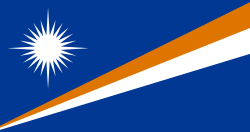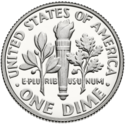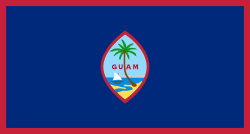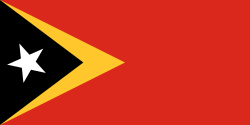Amerikansk dollar
| Amerikansk dollar United States dollar (US-dollar) | |
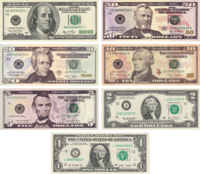 Dollarsedlar | |
| Land | |
|---|---|
| Införd | 1792 |
| Delas i | 100 cent |
| ISO 4217-kod | USD (num. 840) |
| Förkortning | $ |
| Myntvalörer | 1¢, 5¢, 10¢, 25¢, 50¢, $1 |
| Sedelvalörer | $1, $2, $5, $10, $20, $50, $100 |
Amerikansk dollar (engelska: United States dollar, förkortning: USD eller US-dollar), ofta endast dollar, alternativt USA-dollar, är den officiella valutan i USA. Den ges ut av USA:s centralbank – Federal Reserve (FRB) – och är även officiell valuta i Ecuador, El Salvador, Östtimor med flera länder (se valutaunion). Amerikansk dollar används också ofta som reservvaluta utanför USA.[4] Den vanligaste symbolen för USA-dollar är dollartecknet ($). ISO 4217-koden för USA-dollar är USD. 1 USA-dollar motsvarar 100 cent (¢). USA-dollarn har en mycket viktig internationell roll och var 2022 världens största valuta, då den användes i drygt 50% av all internationell handel.[5]
Historia
Efter att representanter för tretton amerikanska kolonier (senare stater) i Philadelphia den 4 juli 1776 skrivit under USA:s självständighetsförklaring och i och med detta utropat den nya staten USA så behövdes det ett eget penningsystem och ett myntverk. Den nyvalde presidenten George Washington bad sin utrikesminister Thomas Jefferson att ta tag i saken. Jefferson tog kontakt med smeden John Harper som den 13 juli 1792 levererade de första 1500 half dimes, eller disme som de också kallades, i silver.
Dollartecknet $
Vissa forskare hävdar att dollartecknet $, som är den vanligaste symbolen för USA-dollarn, härstammar ifrån de spanska silvermynt i valören 8 reales som var vanliga i Nordamerika innan Förenta staterna bildades. På dessa mynt skrevs siffran åtta som bokstaven S med ett eller två lodräta streck, vilket lär komma från det spanska statsvapnet, som de två Herkulesstoderna och mottot Non plus ultra skrivet i formen av ett S. Andra hävdar att dollartecknet är en förenklad version av initialerna US - United States - skrivna ovanpå varandra. Detta är dock föga troligt då dollartecknet användes av spanjorerna innan USA existerade.[6][7][8][9]
Namn
Ordet dollar härstammar från det tyska ordet thaler och motsvaras av det svenska ordet daler.[10] I början av 1500-talet hittade man stora mängder silver i Joachimsthal i Böhmen. Av detta silver producerade man mängder av silvermynt som gick under namnet Joachimsthaler, vilket senare förkortades till thaler. Ett slanguttryck för den amerikanska dollarn är simoleon.
I USA har mynten namn. För 1 ¢ och 5 ¢ är namnen inofficiella, dessa mynt är i stället märkta one cent och five cents istället för penny respektive nickel. För de högre valörerna är namnen officiella; exempelvis är 10¢-myntet märkt one dime.
Ordet penny (plural: pennies, inte pence) är specifikt för 1¢-mynten, så att säga "25 pennies" betyder 25 encentare, inte vilka 25 cent som helst.
Värde
Efter att den svenska kronan etablerades på valutamarknaden i slutet av 1800-talet (då den ersatte riksdalern) har en dollar aldrig varit värd mindre än 3,60 kronor, ett värde den nådde under tiden strax efter andra världskriget då den svenska valutan revalverades. Dessförinnan hade den stadigt stått i en kurs mellan 4,20 och 4,50 SEK för en dollar. När den svenska ekonomin efter haussen som följde andra världskriget kraschade på 1970-talet så ökade värdet på dollarn stegvis, bland annat på grund av de devalveringar som gjordes på kronan. I början av 2000-talet var dollarn värd strax över 11 SEK, men efter 11 september och de finansiella oroshärdar som gick värdet tillfälligt ner.[källa behövs]
Valörer
Sedlar
| Valör | Framsida | Baksida | Porträtt | Första utgåva | Senaste utgåva | Cirkulation |
|---|---|---|---|---|---|---|
| $ 1 | 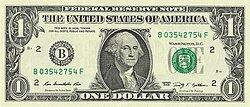 |  | George Washington | 1963 | 2013 | Stor |
| $ 2 |  |  | Thomas Jefferson | 1976 | 2013 | Begränsad |
| $ 5 | 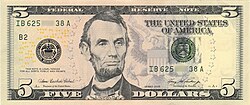 | 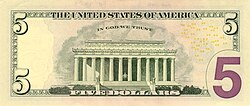 | Abraham Lincoln | 2006 | 2013 | Stor |
| $ 10 | 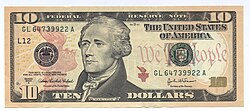 | 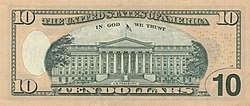 | Alexander Hamilton | 2004 | 2013 | Stor |
| $ 20 |  | 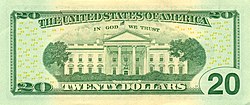 | Andrew Jackson | 2004 | 2013 | Stor |
| $ 50 | 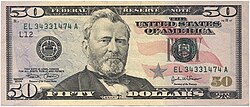 | 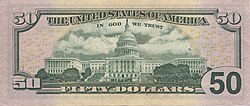 | Ulysses S. Grant | 2004 | 2009 | Stor |
| $ 100 |  | Benjamin Franklin | 2009 | 2009 | Stor |
$ 100 000 trycktes enbart 1934, släpptes aldrig i cirkulation och inga exemplar finns hos allmänheten.

$ 100 är den högsta valören som fortfarande trycks.
$ 2 är relativt ovanliga i cirkulation och $ 50 och $ 100 börjar bli mer ovanliga eftersom amerikanska uttagsautomater endast ger $ 20-sedlar. I synnerhet bensinstationer, snabbköp och snabbmatställen har på många håll slutat ta emot sedlar större än $ 20 eller $ 50.
Mynt
| Valör | Framsida | Baksida | Namn i folkmun | Porträtt | Vikt | Diameter | Material | Cirkulation |
|---|---|---|---|---|---|---|---|---|
| 1 ¢ |  | penny | Abraham Lincoln | 2,5 g | 19,05 mm | 97,5 % Zn täckt av 2,5 % Cu | Stor | |
| 5 ¢ |  |  | nickel | Thomas Jefferson | 5,0 g | 21,21 | 75% Cu täckt av 25% Ni | Stor |
| 10 ¢ |  |  | dime | Franklin D. Roosevelt | 2,268 g | 17,91 mm | 91,67% Cu täckt av 8,33% Ni | Stor |
| 25 ¢ |  |  | quarter (dollar) | George Washington | 5,67 g | 24,26 mm | 91,67% Cu täckt av 8,33% Ni | Stor |
| 50 ¢ |  |  | half dollar | John F. Kennedy | 11,34 g | 30,61 mm | 91,67% Cu täckt av 8,33% Ni | Begränsad |
| $ 1 |  | dollar | Sacajawea | 8,10 g | 26,50 mm | 88,5% Cu, 6% Zn, 3,5% Mn, 2 % Ni | Begränsad |
50 ¢ och $ 1 är relativt ovanliga, dock blir $ 1 vanligare. Ett äldre silverfärgat dollarmynt med Susan B. Anthony finns även i cirkulation. Detta mynt blev dock impopulärt på grund av att det var alltför lätt att blanda ihop med 25¢-mynten.
Amerikanska myntverket, US Mint, gav även ut en serie en-dollar-mynt med bild på de amerikanska presidenterna, i ordning som de tillträdde posten, och endast gällande dem som gått bort, som minnesmynt och samlarmynt. Projektet började 2007 och avslutades 2016. De första åren, 2007 to 2011, präglades mynten i större antal med tanke på cirkulation, men från 2012 präglades de endast som samlarmynt och inte för cirkulation. År 2020 präglades ett samlarmynt för George H.W. Bush, som dog 2018.
Se även
Referenser
- ^ ”El Salvador”. CIA World Factbook. 21 oktober 2010. Arkiverad från originalet den 24 december 2018. https://web.archive.org/web/20181224230021/https://www.cia.gov/library/publications/the-world-factbook/geos/es.html. Läst 27 oktober 2001. ”The US dollar became El Salvador's currency in 2001”
- ^ ”Ecuador”. CIA World Factbook. 18 oktober 2010. Arkiverad från originalet den juni 12, 2007. https://web.archive.org/web/20070612194511/https://www.cia.gov/library/publications/the-world-factbook/geos/ec.html. Läst 27 oktober 2010. ”The dollar is legal tender”
- ^ ”Central Bank of Timor-Leste”. Arkiverad från originalet den oktober 8, 2013. https://web.archive.org/web/20131008020341/http://www.bancocentral.tl/en/currency.asp. Läst 22 maj 2013. ”The official currency of Timor-Leste is the United States dollar, which is legal tender for all payments made in cash.”
- ^ ”The Implementation of Monetary Policy – The Federal Reserve in the International Sphere” (PDF). http://www.federalreserve.gov/pf/pdf/pf_4.pdf. Läst 24 augusti 2010.
- ^ ”Revisiting the international role of the US dollar” (på engelska). www.bis.org. 5 december 2022. https://www.bis.org/publ/qtrpdf/r_qt2212x.htm. Läst 7 april 2024.
- ^ Cajori, Florian ([1929]1993). A History of Mathematical Notations (Vol. 2). New York: Dover, 15–29. ISBN 0-486-67766-4
- ^ Aiton, Arthur S. and Benjamin W. Wheeler (May 1931). "The First American Mint", The Hispanic American Historical Review 11 (2), 198 and note 2 on 198.
- ^ Nussbaum, Arthur (1957). A History of the Dollar. New York: Columbia University Press. sid. 56. ”The dollar sign, $, is connected with the peso, contrary to popular belief, which considers it to be an abbreviation of 'U.S.' The two parallel lines represented one of the many abbreviations of 'P,' and the 'S' indicated the plural. The abbreviation '$.' was also used for the peso, and is still used in Argentina.”
- ^ "What is the origin of the $ Sign?", US Bureau of Engraving and Printing website. Arkiverad 5 maj 2015 hämtat från the Wayback Machine.
- ^ ”etymologiebank.nl”. etymologiebank.nl. http://www.etymologiebank.nl/trefwoord/dollar. Läst 5 maj 2013.
Externa länkar
- Centralbanken FRB
- USD-sedlar
- Historiska och aktuella sedlar från USA (engelska) (tyska) (franska)
|
Media som används på denna webbplats
Reverse of the series 2009 $100 Federal Reserve Note
US 50 dollar bill obverse, series 2004
United States Half Dollar reverse
United States Dime (proof) Reverse
Obverse of the series 2009 $100 Federal Reserve Note. The star in the serial number of this example, LG04727792*, indicates the note is a replacement note.
Reverse of the series 2004 $10 Federal Reserve Note
Removed background, cropped, and converted to PNG with Macromedia Fireworks.
| This image depicts a unit of currency issued by the United States of America. If this is an image of paper currency or a coin not listed here, it is solely a work of the United States Government, is ineligible for US copyright, and is therefore in the public domain in the United States. Fraudulent use of this image is punishable under applicable counterfeiting laws. As listed by the the U.S. Currency Education Program at money illustrations, the Counterfeit Detection Act of 1992, Public Law 102-550, in Section 411 of Title 31 of the Code of Federal Regulations (31 CFR 411), permits color illustrations of U.S. currency provided: Also: COM:ART #Photograph of an old coin found on the Internet |
Jefferson Nickel obverse
The flag of Guam, courtesy an e-mail from the author of xrmap. Modifications by Denelson83.
Framsidan av en 1-dollarsedel från USA, utgiven 2009.
United States Five Cents Reverse
Includes new banknotes
Removed background, cropped, and converted to PNG with Macromedia Fireworks.
| This image depicts a unit of currency issued by the United States of America. If this is an image of paper currency or a coin not listed here, it is solely a work of the United States Government, is ineligible for US copyright, and is therefore in the public domain in the United States. Fraudulent use of this image is punishable under applicable counterfeiting laws. As listed by the the U.S. Currency Education Program at money illustrations, the Counterfeit Detection Act of 1992, Public Law 102-550, in Section 411 of Title 31 of the Code of Federal Regulations (31 CFR 411), permits color illustrations of U.S. currency provided: Also: COM:ART #Photograph of an old coin found on the Internet |
The US 10 bill (front) Series 2004A. The series 2004 $10 bill incorporates new security features such as orange, yellow and red background colors.






